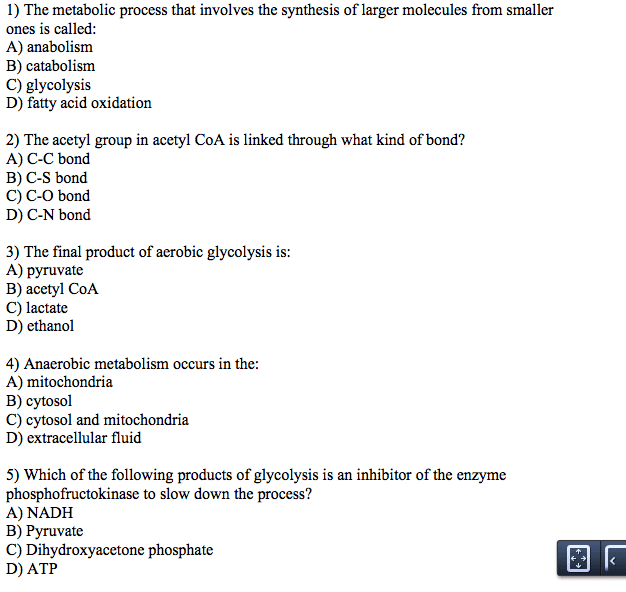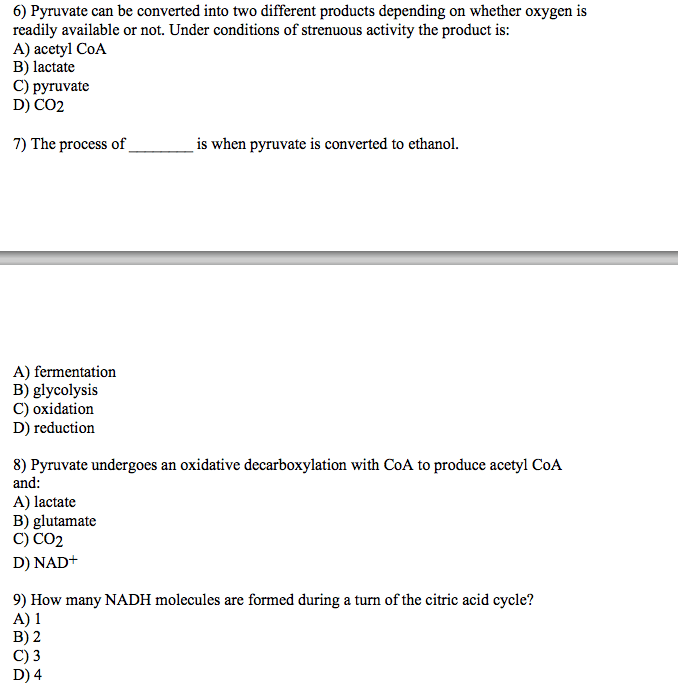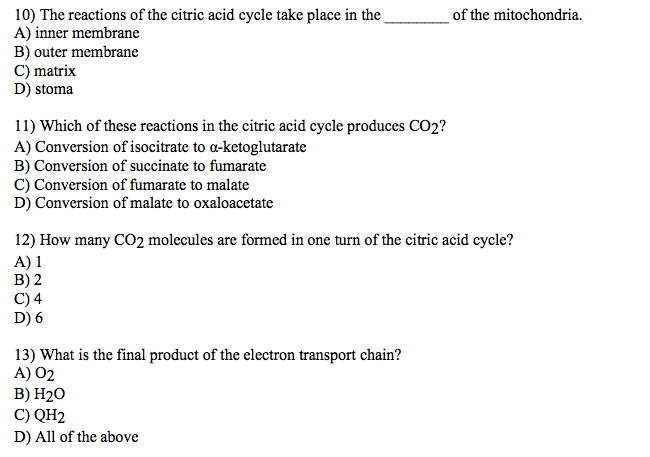Biochemistry Review Questions
What is the classification of the compound shown here?
A) an aldohexose B) a ketohexose C) an aldopentose D) a ketopentose
2. In a disaccharide, the CâO bond that joins the two rings together is called _____.
A) a hemiacetal B) a glycosidic linkage C) an alditol D) an anomer
3. What is the structure of amylopectin?
A) unbranched skeleton of glucose molecules joined by 1ï®4-ï¡-glycoside linkages
B) branched skeleton of glucose molecules joined by 1ï®4-ï¡-glycoside linkages
C) unbranched skeleton of glucose molecules joined by 1ï®4-ï¢-glycoside linkages
D) branched skeleton of glucose molecules joined by 1ï®4-ï¢-glycoside linkages
4. In a disaccharide, the CâO bond that joins the two rings together is called _____.
A) a hemiacetal B) a glycosidic linkage C) an alditol D) an anomer
5. Which type of linkage between the two rings is in the structure shown?
A) 1®4-b-glycoside linkage D) 1®1-a-glycoside linkage
B) 1®4-a-glycoside linkage E) 1®2-b-glycoside linkage
C) 1®1-b-glycoside linkage
6. What is the structure of cellulose?
A) unbranched skeleton of glucose molecules joined by 1®4-a-glycoside linkages
B) branched skeleton of glucose molecules joined by 1®4-a-glycoside linkages
C) unbranched skeleton of glucose molecules joined by 1®4-b-glycoside linkages
D) branched skeleton of glucose molecules joined by 1®4-b-glycoside linkages
7. Which amino acid is a basic amino acid?
A) serine B) arginine C) cysteine D) alanine E) valine
8. What monosaccharide is found in cellulose, starch, and glycogen?
A) glucose
B) galactose
C) N-acetyl-D-glucosamine
D) fructose
E) More than one of the monosaccharides above is found in cellulose, starch, and glycogen.
9. Which is not a reducing sugar?
A) glucose B) fructose C) sucrose D) galactose E) an aldopentose
10. Sucrose contains one _____ unit and one _____ unit.
11. What is the particular sequence of amino acids of a protein that are joined together by peptide bonds called?
A) the primary structure of a protein C) the tertiary structure of a protein
B) the secondary structure of a protein D) the quaternary structure of a protein
12. What is the charge on an amino acid at a pH below its pI?
A) positive
B) neutral
C) negative
D) The charge or lack of charge varies depending on the amino acid.
13. What is the C-terminal amino acid in the tetrapeptide glycylalanyisoleucylmethionine?
A) alanine B) glycine C) methionine D) isoleucine
14. How many different dipeptides can be formed when one valine reacts with one glycine?
A) 1 B) 2 C) 3 D) 4
15. What is the process of altering the shape of a protein without breaking the amide bonds that form the primary structure?
A) hydrolysis B) competitive inhibition C) denaturation D) oxidation
16. Which of the following compounds is an enzyme?
A) glucose C) N-acetyl-D-glucosamine
B) triosephosphate isomerase D) dihydrofolate
17. What is a zymogen?
A) an amino acid with a neutral charge
B) inactive precursor of an enzyme
C) a molecule that causes an enzyme to lose activity
D) a nonprotein organic molecule needed for an enzyme-catalyzed reaction to occur
18. Which of the following will the cause the rate of enzyme activity to first increase and then level off?
A)
increasing the enzyme concentration
C)
increasing the temperature
B)
increasing the substrate concentration
D)
increasing the pH
19. Which of the following make up a nucleoside?
A)
base + sugar
C)
base + phosphate + sugar
B)
base + phosphate
D)
phosphate + sugar
20. Transcription corresponds to which of the following?
A)
the separation of the two strands of DNA to enable the formation of two identical DNA molecules
B)
the transfer of genetic information from DNA to RNA
C)
the transfer of genetic information from RNA to DNA
D)
the use of genetic information to synthesize a specific protein
21. Each individual tRNA contains _____
A) a base sequence that is identical to the informational strand of DNA.
B) the sequence of codons that determines the order of amino acids in the protein.
C) an anticodon of three nucleotides that is complementary to the codon in mRNA and identifies individual amino acids.
D) an anticodon complementary to any of the three stop codons.
22. Where does energy production occur in animal cells?
A) cell membrane B) cytoplasm C) mitochondria D) nucleus
23. How many molecules of CO2 are produced for each turn of the citric acid cycle?
A) 0 B) 1 C) 2 D) 3 E) 4
25. Which is not a reaction found in stage [2] of catabolism?
A) fatty acid oxidation C) oxidative phosphorylation
B) glycolysis D) amino acid catabolism
26. What is the classification of the reaction shown?
A) oxidation D) hydrolysis
B) reduction E) isomerization
C) decarboxylation
27. Synthesis of glucose from amino acids is called
A) Glycolysis C) Gluconeogensis
B) Glycogenesis D) Hydrolysis
28. The synthesis of large molecules from smaller ones in the body is referred to as
A) catabolism C) Ketogenesis
B) anabolism D)glycolysis
29. The nucleic acid base found in the mRNA but not in DNA is
A) Adenine C) Uracil
B) Guanine D) Cytosine
30. DNA rich in A-T base pairs have
A) 1 hydrogen bond C) 2 hydrogen bonds
B) 3 hydrogen bonds D) 4 hydrogen bonds
31. Where does the energy production occur in the cell?
A) Ribosome C) Mitochondria
B) Nucleus D) Cytoplasm
32. Where does the protein synthesis occur in the cell?
A) Ribosome C) Mitochondria
B) Nucleus D) Cytoplasm
33. In the process of transcription, the flow of genetic information is from
A) DNA to DNA C) DNA to protein
B) RNA to protein D) DNA to RNA
34. Ammonium ions are converted to non-toxic nitrogen containing compounds through
A) Amino acid metabolism C) Urea cycle
B) Citric acid cycle D) transamination
35. In protein structure, B-pleated cheats are examples of
A) Primary structure C) Secondary structure
B) Tertiary structure D) Quaternary structure
36. Lactose is a disaccharide formed of
A) Glucose + fructose C) Glucose + galactose
B) Glucose + glucose D) Fructose + galactose
37. Saponification is
A) Hydrolysis of fats by strong base
B) Hydrolysis of glycerol by lipases
C) Esterification
D) Oxidation reaction
38. The connection between amino acid residues in molecules of protein is
A) glycosidic linkage C) peptide linakge
C) ether linkage D) phosphodiester linkage
39. Polyunsaturated fatty acids are generally
A) Oil at room temperature C) Solid at room temperature
B) Semisolid at room temperature D) All of the above
40. Maximum energy is produced by
A) Carbohydrates C) Lipids
B) Proteins D) Nucleic acids
41. A polynucleotide contains _____
A) one free phosphate group at the 5' end.
B) a backbone of alternating sugar and base groups.
C) one free phosphate group at the 1' end.
D) one free OH group at the 5' end.
42. How many molecules of CO2 are produced for each turn of the citric acid cycle?
A) 0 B) 1 C) 2 D) 3 E) 4
43. How many molecules of GTP are produced for each turn of the citric acid cycle?
A) 0 B) 1 C) 2 D) 3 E) 4
44. Which is the enzyme that hydrolyzes triacylglycerols?
A) acetyl CoA D) lipase
B) protease pepsin E) succinate dehydrogenase
C) amylase




